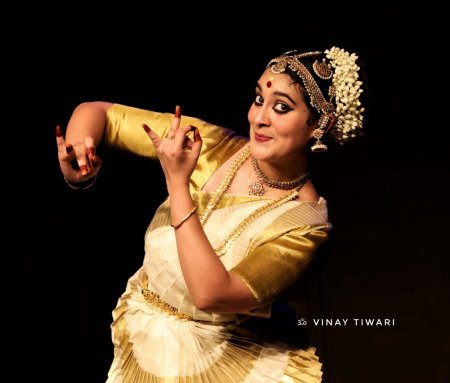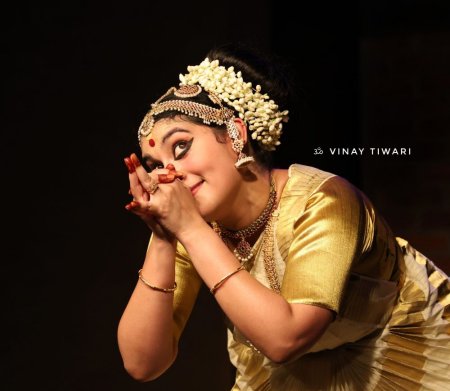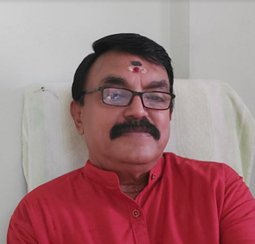
|   |

|   |
An exceptional and distinctive performance of Mohiniattam - SK Venugopal e-mail: venu.sreesankara@gmail.com Photos: Vinay Tiwari January 22, 2025 After a very long time I got to see a Mohiniattam performance in its entirety. Due to busy schedules and difficulty in reaching inconvenient locations, I really missed watching many performances in the past year or so. It was a refreshing experience indeed even though it was an online watch, thanks to Natana Kairali for streaming it live and full. From the start to the end, it was truly an absorbing presentation. The artiste Daniella Zak Varghese was born and brought up in UK. Her parents are Rachel Varghese and Devassya, from Adoor and Changanacheri respectively from Kerala but settled in UK. She began her dance training in Bharatanatyam from the age of 3 under Vinodini Bharathan (Kala Niketan, U.K) as also Carnatic music vocal and violin from the same institute. At the age of 13 she began training in both Bharatanatyam and Mohiniattam under the guidance of Shalini Shivashankar (Uphaar school of dance, London). She did her arangetram in Mohiniattam in May 2019 and Bharatanatyam in June 2019. 5 years since then she took a conscious decision of focussing completely on Mohiniattam and chose to train under the septuagenarian guru of Mohiniattam, Nirmala Panicker, who is a disciple of late Kalamandalam Kalyanikkutty Amma, the most revered guru and reformer of Mohiniattam, also called the mother of Mohiniattam. Daniella has been learning under Nirmala Teacher ever since, both online and offline. Daniella is presently working as a Program Manager for FCDO (U.K. Government), but she is inclined to pursue her Mohiniattam both in performing and teaching. She is married to Prasanna Venkatesh (Chennai).  She started her performance with an invocative piece on Ganapathy, written, composed and choregraphed by Nirmala Panicker. In this, she depicted Lord Ganapathy in child form or 'Bala Ganapathy' and described the lovable qualities of the Lord including his love for food. Born to Lord Shiva and Sakthi, he is considered as a remover of all obstacles, the artiste conveys. The composition was in raga Nattai and in adi talam. Her portrayal of Ganapathy's characteristics with detailing of features with expressions to match, was quite typical of Nirmala teacher's school of Mohiniattam. The next item was Cholkettu, which is traditionally performed as the first item in Mohiniattam performances. A few syllables tied together is the verbatim meaning of 'Cholkettu'. The scope for swaying movements which is the essence of this beautiful dance form, makes this item so attractive. Beginning with a slokam in praise of the Goddess and ending with a verse in praise of Lord Shiva, the artiste demonstrated her skills performing the advaus perfectly blending with the accompanying music, the 'chollus' or 'vaitharies' as they call it. This was followed by Jathiswaram, a combination of Jathis and Swaras in tune with the rhythm (misrachapu talam) within the framework of raga Hamsadhwani. The dancer exhibited pure nritya well and truly in the typical and traditional style being followed by her guru. The music did compliment the artiste's attractive and graceful moves, making it an absorbing watch. The next item was based on a renowned Malayalam poem 'Karukare karmukil' by Late Kavalam Narayana Panicker, often celebrated as the rain song, announcing the arrival of monsoon in Kerala. The poet depicts the dark, rain laden clouds as a majestic tusker, stepping ahead with regal splendour, carrying a deity on his back and moving across the sky in a grand procession. The poem's imagery was so beautifully captured in the choreography by Nirmala Panicker, depicting the vibrant images of the monsoon by amalgamating the old tradition of 'thudichukuli' prevalent in ancient Kerala, where women used to gather to splash and play in ponds / rivers, resonating with the spirit of the monsoon, the 'mayilattam' (peacock dance) where she compares the moving clouds to dancing peacocks and then equating the shifting and swirling of the clouds to the graceful 'mudiyattam' (hair dance), like how peacocks spread their vibrant feathers. As beautifully expressed by the poet in the next verses, the choreography excelled in showing how the rainy season gives way to arrival of new sun, symbolising hope, and renewal, with the once barren land now brimming with life readying for harvesting season. The poem concludes with 'Vallamkali,' the traditional boat race, which again was very aesthetically merged into the choreography by Nirmala Teacher. Her desi style of Mohiniattam indeed is so exciting to watch, as she mixes the beautiful aspects of our tradition like how she introduces in this piece, the 'thudichukuli', 'mayilattam' 'mudiyattam' etc, even while strictly adhering to classic Mohiniattam style she inherited from her Guru Kalamandalam Kalyanikkutty Amma. The item finally concluded with two lines written by Nirmala Teacher, which was in praise of our beautiful homeland Kerala. Daniella did complete justice to this choreography of her guru, with elan. Her graceful moves and overall stage presence were elegant.  The next item was "Krishna Mukunda Murare", a short piece describing the qualities of Lord Krishna. He is addressed as ocean of compassion, consort of Goddess Lakshmi and the one who wears golden robes. The artiste then goes on to show how the pride of Kaliya was demolished by Krishna by the act of 'Kaliya Mardanam' and then the slaying of Kamsa by the lotus eyed Krishna. More of an abhinaya piece, the presentation was short and sweet. The last item of the evening was 'Kurathi', one of those popular and unique choreographies of Nirmala Panicker along with Poli, Chandanam, Esal and Mookkuthi, which were the results of her untiring efforts to revive the decades old desi style of Mohiniattam. The choreographies have earned her so much of accolades for doing something off the beaten track and being so fresh and incredible. The item is like 'Saptham' in traditional Mohiniattam Kacheri. In this item, the Kurathi is the storyteller who belongs to the mountain tribe. She claims that she can even climb mount Kailasa and also that she is adept in palmistry. She says in her comical best that she is not a simple Kurathi, but a manifestation of Lord Mahavishnu in the form of Kurathi (a tribal woman). The Kurathi then goes on to tell the story of how Lord Shiva got attracted to the alluring beauty of Mohini, the stunning form of Mahavishnu and how out of their union a child was born, who later became Lord Ayyappa, the most revered and loved deity of Kerala. The chants of chorus of 'Swamiye Sharanam Ayyappa' reverberates throughout the land of Kerala during the Mandala season from November to January. Kurathi talks of the devotional rituals and fasting observed by the devotees and then the final moment of enlightenment after they reach in front of the sanctum sanctorum at Sabarimala and be one with the Lord. The composition was in Ragamalika. The nuances of the Kurathi, the folk character was very well portrayed by Daniella. Overall, it was a very enjoyable feast of Mohiniattam, in the beautiful ambience of Natana Kairali, in the august presence of her Guru Nirmala Panicker. Daniella deserves to be congratulated for her efforts in travelling all the way from UK and pursuing this beautiful dance form. With more of learning and practice, she has immense potential to be among the topmost exponents of this dance form. Music credits include Neelamperoor Sureshkumar on vocal, Murali Krishna on veena, Kala Nilayam Prakash on maddalam, and Kala Nilayam Ramakrishnan on edakka.  SK Venugopal is a businessman in the field of Engineering projects, a singer, composer, accredited artist in Light Music at All India Radio, auditioned and graded member of panel of speakers in Films Division of India, who is associated with Mohiniattam as accompanying musician and music composer. |